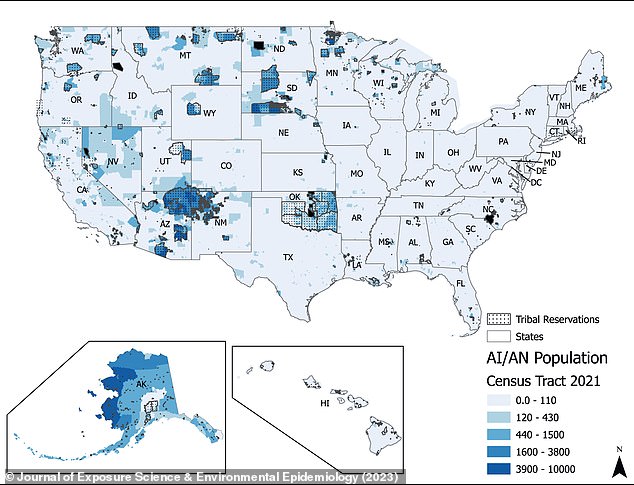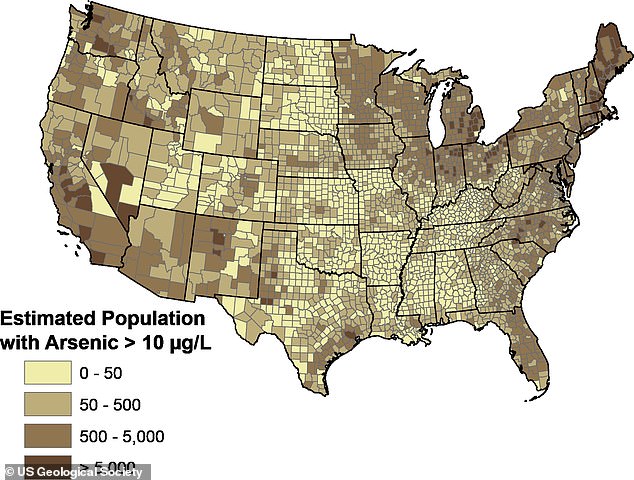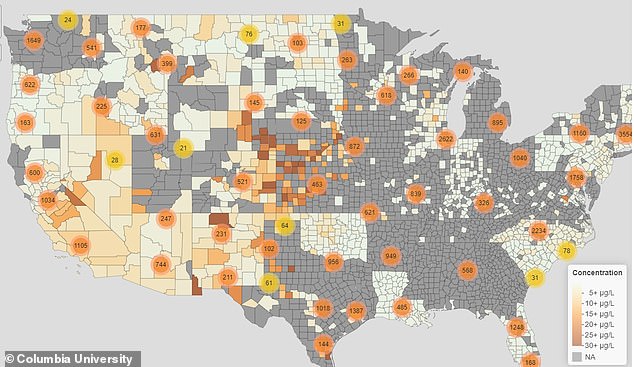Scientists find at least SIX toxins like arsenic and uranium in systems used by 95% of the US population
About 95 percent of the U.S. population drinks water from wells and community systems that contain unsafe levels of toxic contaminants, a new study finds.
Scientists at the University of New Mexico have identified at least six pollutants, mainly arsenic, nitrates, uranium and lead, that are linked to neurological and developmental problems.
Fracking fluids and PFAS were also found in the drinking water that also flows to the homes of approximately 320 million Americans.
The six contaminants represent a small fraction of the thousands of chemical agents present in drinking water, the authors report.
The team also warned that two or more contaminants could be present in a water source, “raising the possibility of synergistic effects,” the researchers said.

About 95 percent of the U.S. population drinks water from wells and community systems that contain unsafe levels of toxic contaminants, a new study finds. The image shows a map showing the locations of the tribal population most affected by toxins in the waters
“The seven contaminants and groups of contaminants presented here represent a small fraction of the thousands of regulated and unregulated chemical agents present in drinking water,” reads the study published in Nature.
‘This assessment illustrates the complexity of the range of chemical hazards in our drinking water and highlights the need for a concerted effort to invest in upgrading our drinking water infrastructure, strengthening drinking water standards, developing and implementing improved water treatment, collecting and disseminating of monitoring data and require more stringent chemical safety testing to support the well-being of all U.S. residents.”
Arsenic
The team found that arsenic is detectable in more than 50 percent of community water systems (CWSs), with 2.6 percent exceeding the maximum contaminant level (MCL).
These high levels were found in the Southwest and Great Plains regions of the US, where hard rock mining processes and mine tailings occur.
Arsenic has long flowed through drinking water systems, but although the MCL is 0.010 micrograms/liter (µg/L), parts of the US have seen higher levels.


The team found that arsenic is detectable in more than 50 percent of community water systems (CWSs), with 2.6 percent exceeding the maximum contaminant level. This map shows estimates of how many private household well users in each province may be drinking water with arsenic levels that may be of concern to human health.
The study highlights that average arsenic concentrations nationally from 2009 to 2011 were 1.70 µg/l.
The highest were in communities categorized as semi-urban and Hispanic (3.40 µg/L); communities in the southwestern US (3.18 µg/l); communities with fewer than 500 inhabitants; communities dependent on groundwater sources; and incarcerated populations in the Southwest (2006-2011, average 6.41 µg/L),” the studies shared.
Repeated exposure can damage DNA, weaken the immune system and lead to the formation of cancer cells, as well as high blood pressure and heart disease.
Pipe
Detections of lead stem from America’s history of using the material for water system piping in the 19th century.
However, lead pipes continued to be installed in the US until they were banned in 1986, including in places such as Chicago, which until then had required the installation of lead pipes.


The six contaminants represent a small fraction of the thousands of chemical agents present in drinking water, the authors report
The Environmental Protection Agency (EPA) does not have a set MCL for lead, but has established a treatment technique that requires systems to control the corrosiveness of their water.
If more than 10 percent of tap water samples exceed the Action Level (AL) of 0.015 mg/L, water systems must take additional steps – part of the Lead and Copper Rule (LCR).
The study highlights research from 2021 that found 186 million Americans receive water from CWSs with detectable lead contamination.
And a majority of these people live in minority and low-income communities.
Lead is also highly toxic and associated with adverse health endpoints in virtually all body systems, including nervous, cardiovascular, renal, immunological, hematological, and reproductive/developmental systems in men and women, adults and children.
Uranium
Uranium occurs naturally in the earth’s crust and enters water systems through geochemical processes.
Previous studies have shown that 74 percent of Americans have traces of the substance in their urine, and that it accumulates in the human body in the bone and kidneys.


Uranium occurs naturally in the earth’s crust and enters water systems through geochemical processes. The EPA’s map (photo) shows elevated uranium levels in two-thirds of community water systems
Alpha radiation from uranium decay is classified as carcinogenic, and mounting epidemiological evidence shows that exposure to uranium in its metallic form is associated with chronic kidney disease and neurological, reproductive and cardiovascular toxicity.
According to data from the U.S. National Water Information System (NWIS), 50 percent of domestic water wells in the U.S. contain detectable concentrations of uranium.
Nitrates
“Nitrate levels in water supplies have increased worldwide due to the application of chemical fertilizers and animal manure in agricultural areas,” the study reads.
“Pollution sources also include septic systems that do not effectively remove nitrogen and wastewater treatment plant discharges, as well as atmospheric deposition of nitrogen oxides and fertilizer use on lawns, golf courses and parks.”
The team found that in 2019, about 5.6 million Americans were exposed to levels above the maximum limit.
These levels were detected primarily in Washington State’s Yakima Valley and California’s San Joaquin Valley.
Consuming too much nitrate can affect the way the blood carries oxygen and cause methemoglobinemia, when the hemoglobin can transport oxygen but cannot deliver it effectively to the body’s tissues.
Fracking-related substances
These substances come from oil and gas that are extracted from deep underground through wells.
There are 150,000 active wells nationwide, and more than nine million Americans depend on drinking water sources within a mile of these locations.
Fracking fluids and wastewater from the process can contain toxic, radioactive and carcinogenic chemicals.
And the research shows that up to four percent of leaks go unreported.
PFAS
Per- and polyfluoroalkyl substances (PFAS) are synthetic chemical compounds used in cleaning products, certain fabrics, nonstick cookware, and other items.
According to the National Health and Nutrition Examination Survey (NHANES), more than 98 percent of the U.S. population has detectable levels of PFAS in their blood.
“The highest levels of PFAS in drinking water have been found near industrial facilities where PFAS are manufactured or processed and sites with aqueous film-forming foam (AFFF) discharges at military bases, major airports, and other fire training areas,” the authors said.
The study shows that up to 80 million Americans are receiving water contaminated with high levels of PFAs.
In 2023, the EPA estimated that 70 to 94 million people in the US will be exposed at elevated levels to six PFAS of concern in their drinking water.
